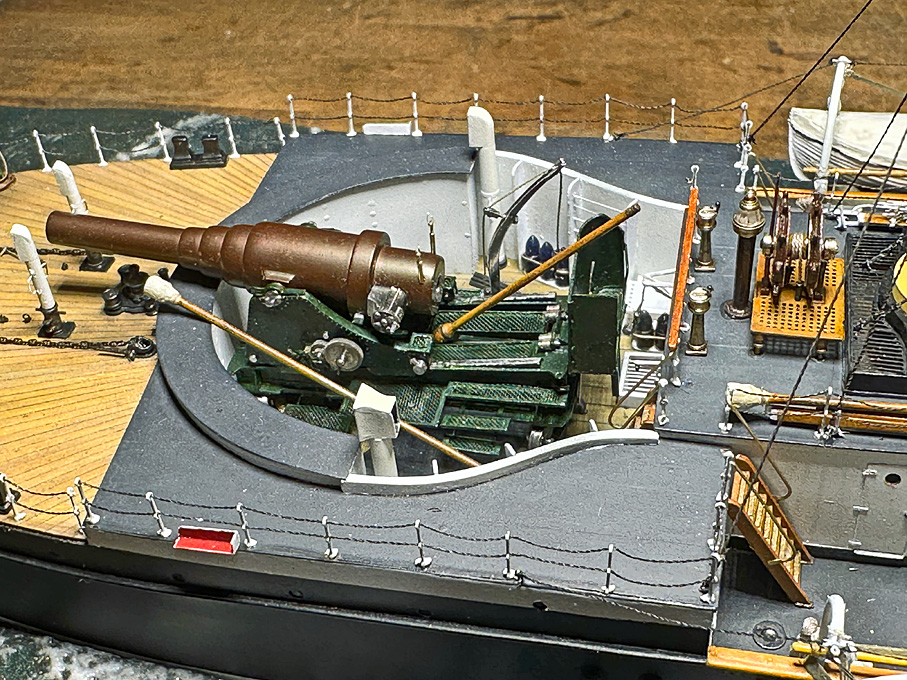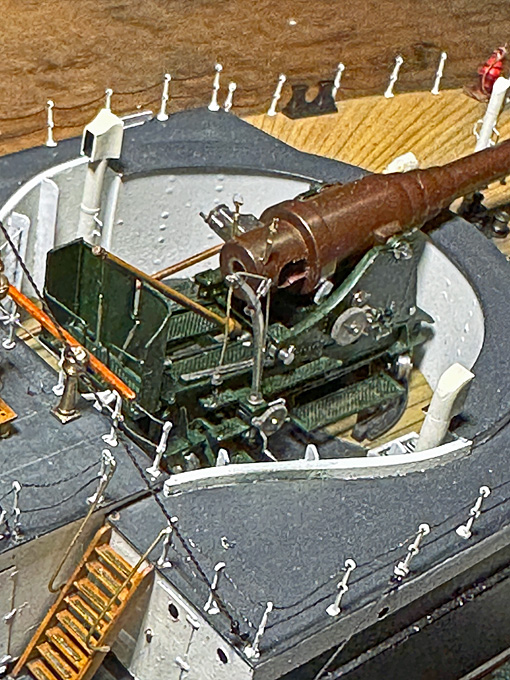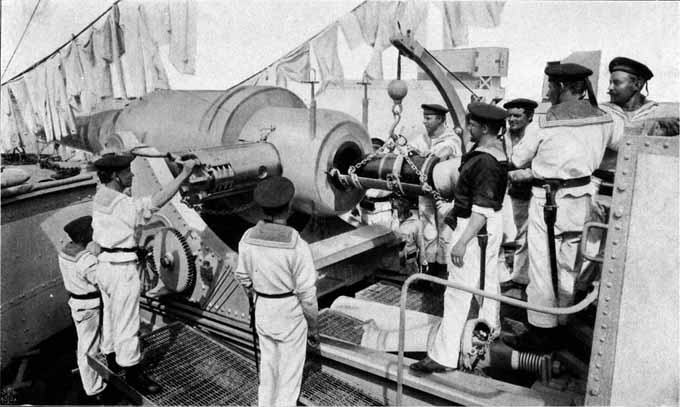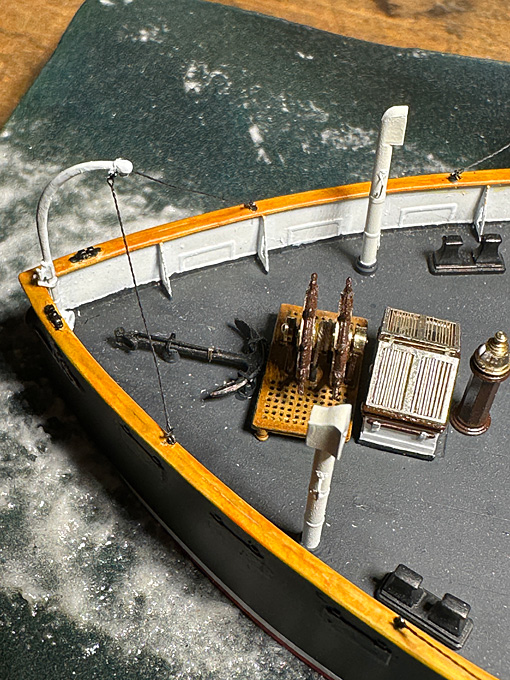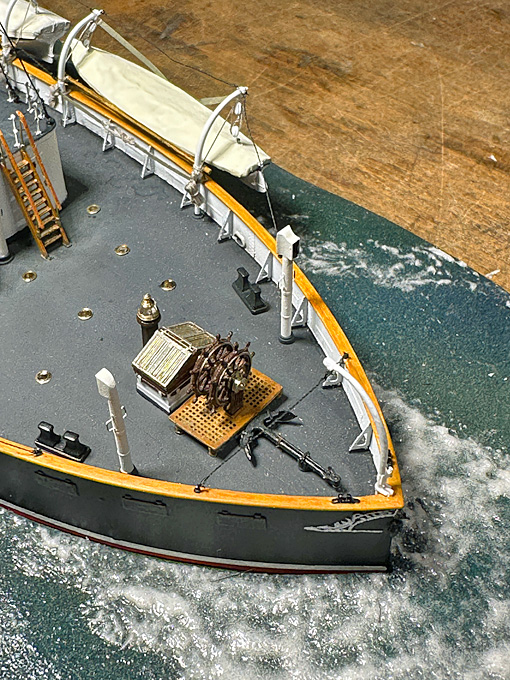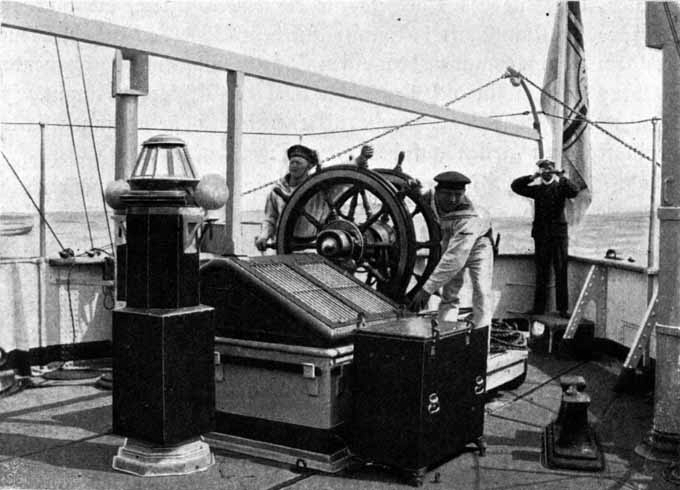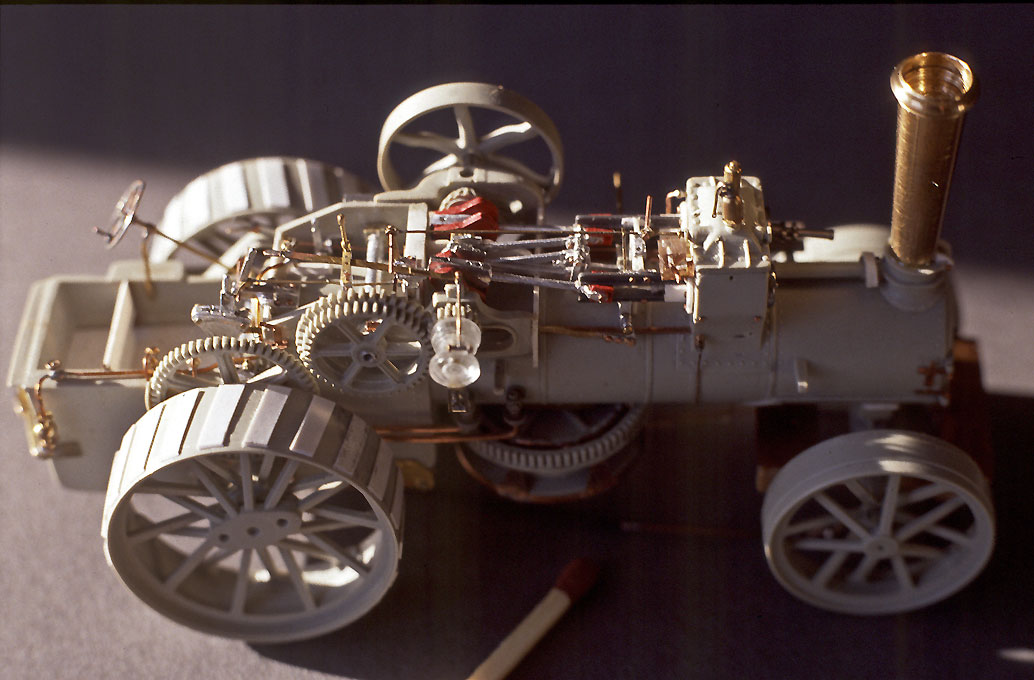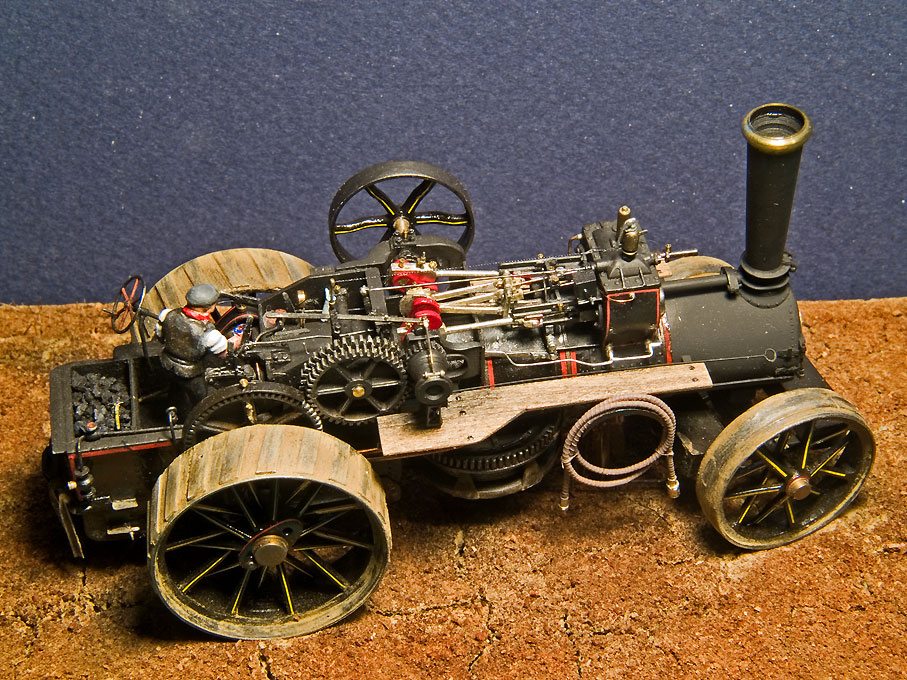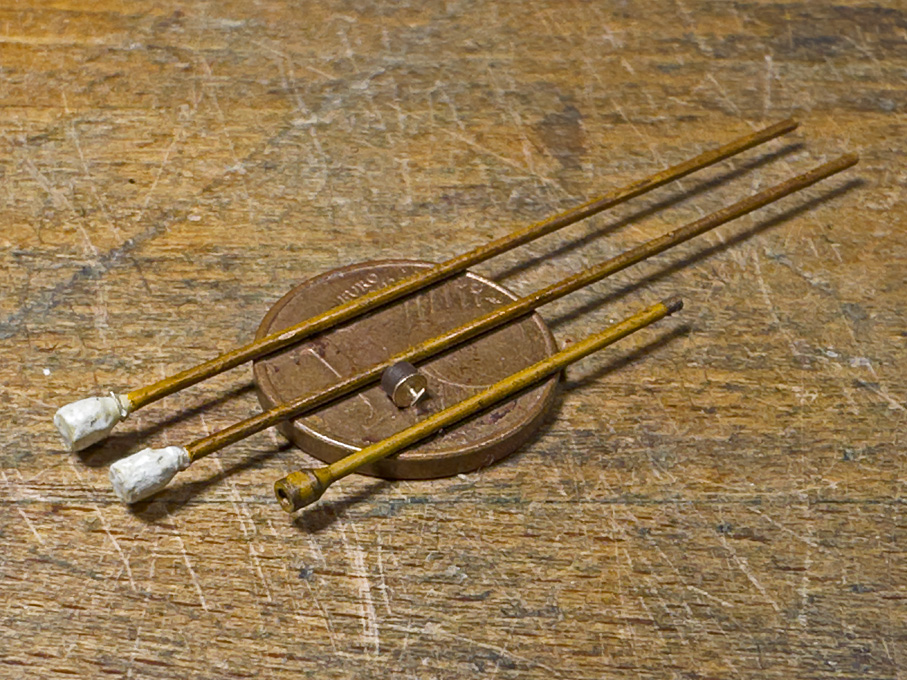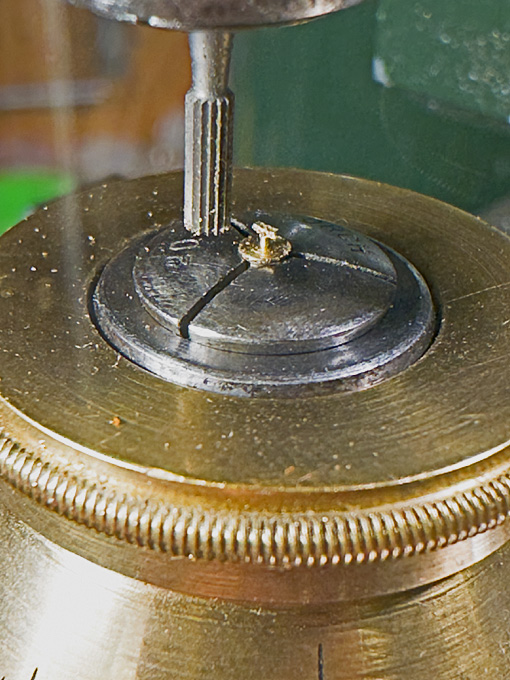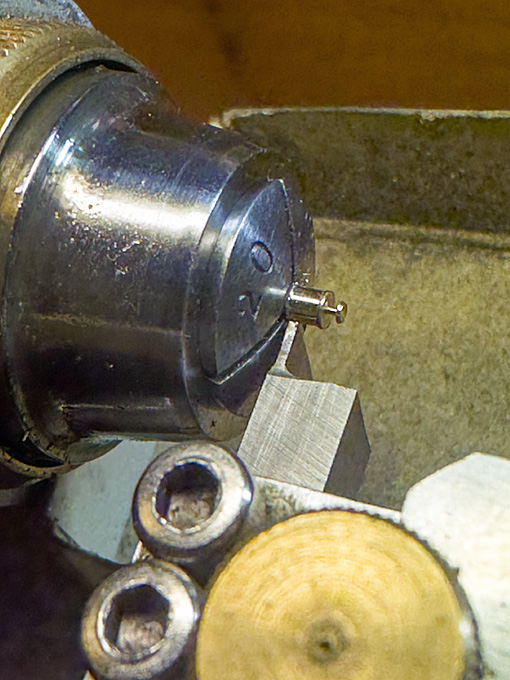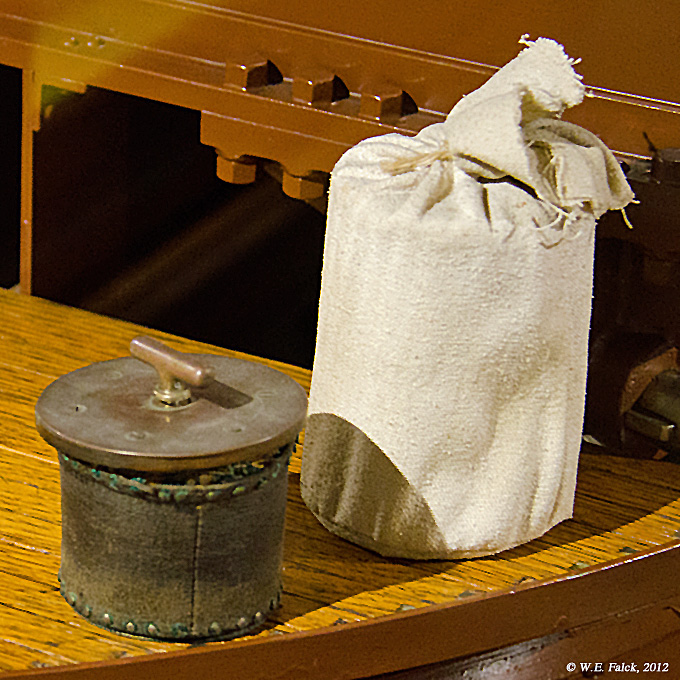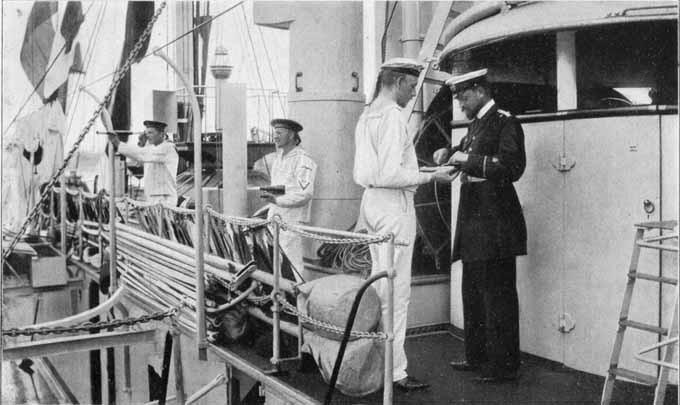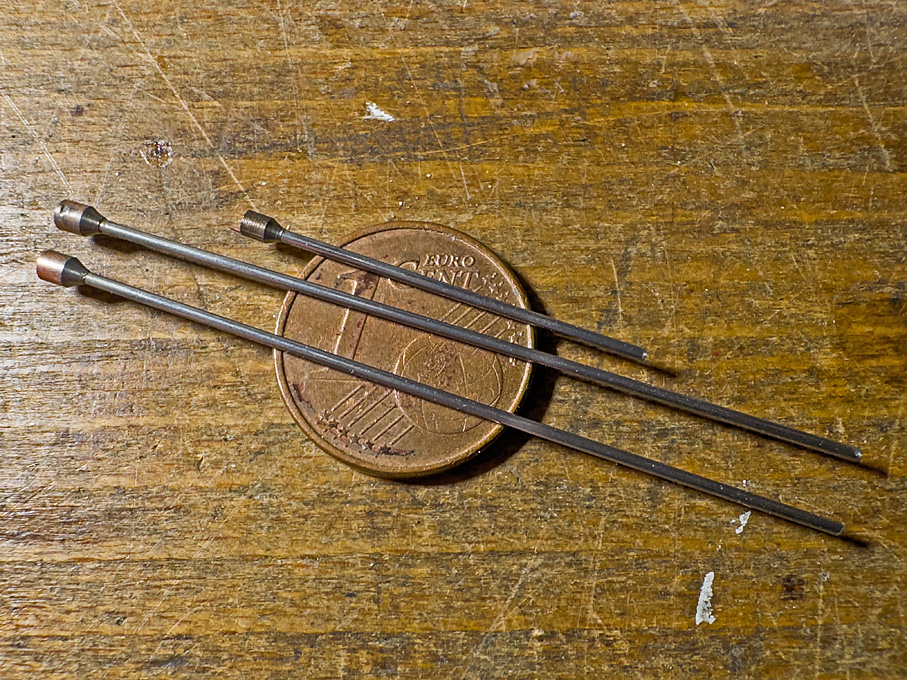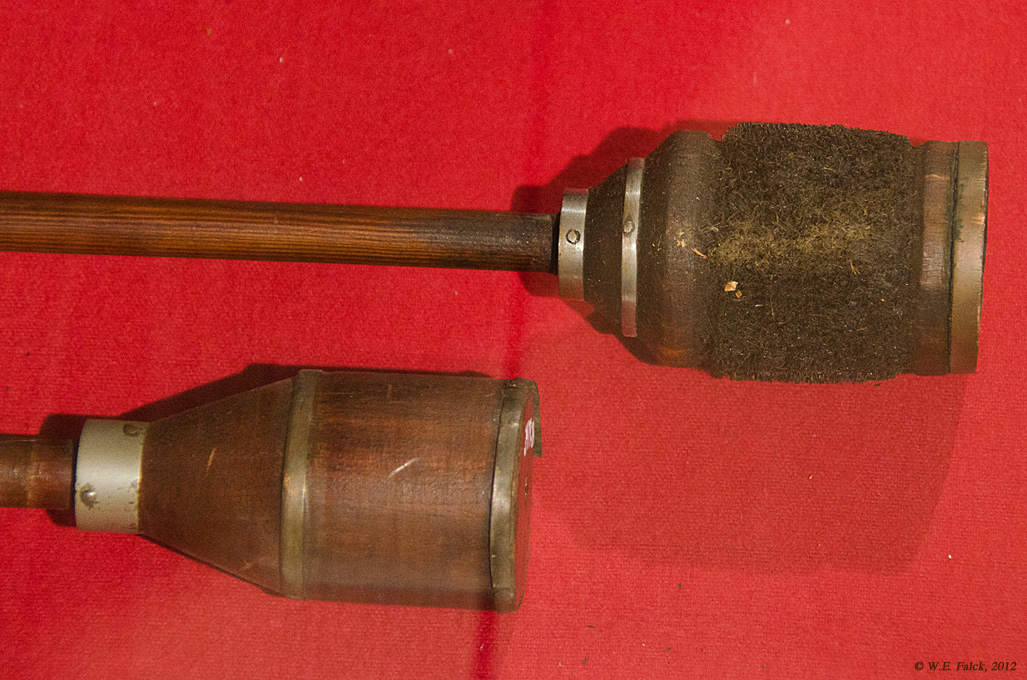-
Posts
6,360 -
Joined
-
Last visited
Content Type
Profiles
Forums
Gallery
Events
Everything posted by wefalck
-
Just a little bit of further progress before the Easter-weekend … Stern anchor-crane There are drawings as well as the photograph below that show the anchor-crane in some detail. Basically, the dimensions are the same as that of the boat-davits, so that I was able to use a spare one that was left over. The ball at the end was drilled for the ring into which during service the anchor-tackle would be hooked. When not in service, the davit was steadied with two chain-stays. The set-up is very similar to that of the boat davits and the same processes were used. Gun-sights Gun-aiming technology didn’t significantly progress until towards the end of the 19th century. Just very basic front sights were used that sat on the trunnions, while the rear sights were adjustable in height for different distances and laterally for lead-angles. The rear sights used on the 30,5 cm gun a clearly visible on photograph below. Galster (1885) gives a detailed description. Basically, it is brass-tube of about 4 cm diameter that is set into a whole drilled vertically through the rear of the gun. In this tube runs a graduated brass-rod for setting the elevation as a function of the type of projectile used and the size of the powder charge. Firing tables were provided with the gun. On top of the rod is a cross-piece that runs in a dovetail-slot and allows to pre-set the lead-angle. The lead-angle was calculated inter alia on the basis of the estimated relative speed of the target and its distance. There was the usual V-notch on the top of cross-piece. It took several tries to produce these tiny pieces. In the end their dimensions are slightly over-scale due to the limitations of machining brass. Starting from 0.8 mm brass-nails, which are slightly harder than the usual brass wire due to the forging process, a 1.5 mm length of 0.2 mm diameter was step-turned over short lengths successively. Then a 0.2 mm long length was turned down to 0.7 mm diameter and this ‘rod’ with a disc at the end parted off. Luckily, I have a 0.2 mm collet for the lathe, so that the part could be inverted and the parted-off end cleaned up. With a pair of cutting-tweezers the disc was clipped down to the size of the cross-piece. Burrs were removed with a fine file. This part fits into a 2 mm long section of 0.3 mm OD brass-tube (from Albion metals). When I made the gun-barrel in about 2008, I did not have really the technology to safely drill to any depths the 0.3 mm holes for the sights, I was glad to be able to mill the flats with a broken drill that I had ground flat at the end. With my micro-milling machine and the dividing head this would not be a real issue anymore. Unfortunately, I forgot to do that before painting the barrel. Therefore, the sights had to be simply cemented onto the flats with a tiny drop of shellac. Before doing that I also added the protective frames over the sights using some 0.007 mm diameter silver-wire. Also installed were the last two of the ventilators for the officers’ mess. What remains now is the flagstaff and the ensign. I have already found a suitable technique for the complex ensign of the Imperial German Navy, but have to still get the right red for it. And then on to the crew … To be continued ....
-

Ship Ribbing with CAD?
wefalck replied to Sanjith_D's topic in CAD and 3D Modelling/Drafting Plans with Software
Well, it depends what you are doing with them on a ship model ... Actually, I think there are four different topics here: 1) how to convert a 2D-paper drawing into a CAD-drawing 2) how to loft such drawings into a self-consistent data-set that produces a fair hull, and 3) how to convert the resulting CAD-drawing into instructions for the laser-cutter that produce the expected results. 4) is the laser-cutter available suitable for the task in hand As Chuck suggested, it may save a lot of time, effort and money to verify point 4 first. If the available laser-cutter is not suitable, it may be simpler to work the traditional way. On the other hand, as the envisaged model is planned to be only a foot and a half long, one may get away with quite thin (ply)wood or even cardstock. The bulkheads are only needed to define the shape of the hull, if the spaces in between are filled with a softer wood, e.g. balsa. The bulkhead do not need to be structural parts. One has to adapt the building technique to the available tools, in this case the laser-cutter. Some people work from sets of copies of original builders' plans, but it may be worthwhile going through steps (1) and (2) in any case, as this allows you to verify the fairing of the hull before one cuts anything. Even going only through step (1) is useful: if it turns out that a bulkhead is wrong, one can easily correct it in the 2D-CAD and print it out again. -

Krupp 420mm Big Bertha by Haliburton - Takom - 1/35
wefalck replied to Haliburton's topic in Non-ship/categorised builds
Well, it seems that Gruson in Magdeburg specialised in 'Hartguß' for armour and armour-penetrating projectiles: https://de.wikipedia.org/wiki/Grusonwerk. I would need to bring myself up to speed as to the metallurgy of the various types of 'Hartguß' developed for armour and amunition by Krupp, Gruson and others. Both the metallurgy and the processing determine the their properties for different applications. My area of interest in general is before 1890, so I am not so familiar with the later materials. To my knowledge HSS-tools were the only ones available to turn/mill steel during WW1. Carbide (WiDia) tools were only invented in 1926. So pre-forming shells by drawing and drop-forging saved a lot of difficult machining and, as noted before, aligns the grain in the material favourably. I gather the classification of artillery into guns, howitzers and mortars became a bit fluffy in the course of WW1, as certain howitzers were given a maximum elevation more like that of mortars. They became effectively longer-range mortars. Or, one could say that mortars were made longer in order to give the projectiles a greater V0. -

Krupp 420mm Big Bertha by Haliburton - Takom - 1/35
wefalck replied to Haliburton's topic in Non-ship/categorised builds
I didn't actually say that the shells as such were cast. I was referring to a special steel-alloy developped from the 1870s or so on by Krupp, which in German was called 'Hartguß'. Say in the 1880s, the shells, to my knowledge, actually were cast into cockilles, where the quick cooling surface hardened them. Howitzers like the one we are talking about were designed to destroy bunkers and other hardened facilities, so the shells need to be hard and tough. Too soft and they will use much of their kinetic energy for deformation and the energy will be distributed over a too wide cross-section - too hard and they will fragment on impact, again dispersing the energy. At that time, turning hardened steel was difficult to machine, so they wouldn't turn and bore shells from solid bar-stock. Rather, a process of drawing and drop-forging was used to give most of the shape. Drawing and forging also arranges the structure within the steel, to make it tougher. The square billets from which the process started in the film were presumably cast. Not sure, whether continuous casting and hot cutting would have been available at that time. At 16'10" in the film one can see that even late in the war (I gather the film is 1917/18ish) the shells were painted and were given painted/stencilled marks as to their type. Otherwise they may rust quickly, even if greased for the transport to the front. Firing a rusty shell would not be good for the gun and may difficult to load. Interestingly, our peace-time stocks and production capacities are just not capable of keeping up with war-time demands, as the war in Ukraine shows again. These large artillery barrels had only a limited life-time, after a certain number of shots they would be worn out. Peace-time shell supply presumably was calculated on this basis. -

Krupp 420mm Big Bertha by Haliburton - Takom - 1/35
wefalck replied to Haliburton's topic in Non-ship/categorised builds
@Jack12477, the young gentlemen seated to the right is wearing 'knickerbockers' or 'plus-fours' - this was the hip outdoor sports attire from the late 19th century to around the 1930s. They were used when cycling (no chain-guards, so that the trousers don't get caught), golfing (to prevent trousers getting dirty), hunting (same reason), etc. While not acceptable at formal occassion (unlike today), they were worn to show that you were a sporty person (very much like today people are wearing those horrible track-suits and the likes, even when they are not pursuing any sports). As to the colour and appearance of the projectiles: they would have been special 'hard-cast' steel, so when bare, a metallic grey. There would be also two or three guidance rings that are pressed into the rifling, probably copper or perhaps brass. The detonator (which in this case may be in the bottom of the shell) would be brass. I don't know what the WW1 practice at that time in Germany was, but normally shells would be colour-coded according to the type. I would assume that they were painted 'field-grey' or something like that to prevent rusting, perhaps with coloured bands or lettering to indicate the type. You would need to verify this against the literature. -

Ship Ribbing with CAD?
wefalck replied to Sanjith_D's topic in CAD and 3D Modelling/Drafting Plans with Software
I think this has been discussed before, watch out for key phrases, such as 'digitising plans'. In general you can import an image of the body plan into your CAD system and then retrace the frames. Once this is done, you have to complete each frame station with the contours of what you actually want to cut. I gather so are aiming for a so-called POB (plank-on-bulkhead) construction. So you need to draw the respective lines for cutting out. There is a lot more detail that has to go in than can be described in such a short post. You should look at the various contributions in this section here to get an idea. Once you have the basic hull representation in the CAD system, you have to turn this into the files needed for laser-cutting, i.e. arranging the pieces to be cut to fit the machine, efficiently use the wood etc. This file has to be saved in a format that is readable by the laser-cutting software. I gather there is also information on that in this section of the forum. Not sure that basswood is a good choice, I think plywood would be better. -
In general, when the bowsprit is next to the stem, rather than on top of it, you are likely looking at a running bowsprit. For obvious reasons, in this configuration there is no gammoning, but either an opening in the bulwark or an iron ring to hold the bowsprit down. Gammoning seems to be also associated mainly with galion-style bows. As one can see from the first two illustrations above, a closed bow would requires some akward arrangements for the gammoning as the stemhead is too narrow. When closed bows came into fashion around the middle of the 19th century the gammoning was replaced by wooden clamps or iron straps.
-
Looking good, the work! Somehow I thought that the exhaust pipe(s) from the safety-valves are connect to those steam-relief pipes that are attached to ships' smoke-stacks. Unlike for railway- or traction-engines and the like, you cannot just let the steam off into the the (usually enclosed) engine-room. Do you have drawings of the prototype arrangements?
- 128 replies
-
- zulu
- sternwheeler
-
(and 1 more)
Tagged with:
-
I haven't build anything with decals since about 1980*, I think. Decal technology must have advanced considerably since then. If I understand the process correctly, then you can apply the 'softener' to already set decals in order to coerce them around obstacles? I am asking this question, because I just had the idea of laser-printing flags onto decal-sheet and then apply the decals on both sides to a piece of aluminium foil cut to the right size. With this softening and drying technique, the aluminium foil with the decals on could be 'draped' realistically. Does this sound feasible? *apart from the white boot-topping above the waterline that I put onto my current project, for which I used thin strips of white decal-sheet.
-
Thanks, gentlemen. I have not intention to leave this World in the next few months, so this is not going to be a 'project for life' 😉.
-
OK, we are in serious thread-drift now ... the phenomenon we are discussing is called 'planned obsolescence'. It's something industry has been using for decades to keep up their sales. Perfectly useable hardware is made unserviceable by designing electronic components too flimsy so that they fail prematurely, well before the actual hardware is worn out. Or making software on purpose not backward compatible anymore, claiming that otherwise performance cannot be improved (even if objectively no improvement may be needed). The component concerned are often trivial, such as capacitors, but one has to replace the whole electronics and replacements are either not sold or made uneconomically expensive. In fact, the European Commission has been working for some years now on legislation to curb such practices, because they are wasteful of mineral resources and energy. I gather, as long as our economic philosophy is built on 'growth', it is difficult to combat such practices. Another dimension of the problem is, that industry faced with this 'threat' is switching to renting out 'services', rather than selling goods. To some degree this is also supported by environmentalists, as they claim that there is too much 'unused stock' in our society. Gone are the days (well into the 1990s) that Apple prided themselves that all their operating systems were backward compatible with existing software (their own). You could run ten-year old versions of wordprocessors on the latest version of the operating system. But even back in the 1990s already there were complaints that 'productivity' software had too many bells and whistles that very few people actually use in practice. Perhaps I am not such a sophisticated user, but there are very few functions that I constantly use in my wordprocessor, spreadsheet or drawing programs that were not available already 30 years ago ...
-
I am a great fan of Fowler traction engines, because of their looks and perhaps also because of their German connection: a young German engineer in search for better opportunities than on the continent ended up with Fowler in the 1860s. He made some important inventions/improvements to their ploughing engines, reorganised the Egyptian cotton industry with the help of Fowler engines and eventually became their agent for the German states and Eastern Europe with a seat in Magdeburg. Some 35 years ago, I built a Fowler Z7-type ploughing engine from a 1:76 Keil-Kraft kit (which at that time were readily available in model shops) with a lot of 'scratch'-building, as I had just acquired a watchmakers' lathe. The actual engine was virtually absent from the kit and various other aspects of the kit had to be corrected: Before painting showing the amount of detail added to the Keil-Kraft kit. Finished and painted Fowler class Z7 ploughing engine in 1:76 scale. I was lucky to live in the UK at the time, so I could visit various steam-fairs to take pictures of originals and there was also a local museum that owned a class BB ploughing engine. I didn't know that there was an 1:35 scale kit of a class B6 traction engine. I always wanted to build a model of those. The kit looks good, but it is a pity that the whole engine-block has been cast in one piece. I would want to make the metal parts from real metal ... does the kit come also with wheels with rubber tyres? This is the configuration as agricultural engine. Not sure what the army would have used. The agricultural wheels would give more traction 'off-road', but are rather uncomfortable to ride on paved roads. Incidentally, the German army experimented with traction engines as artillery tractors in the 1870/71 Franco-German War. I believe they were Fowler engines. There are not many accounts of their performance in the published literature - military writers of the time mostly were no techno-freaks and quite conservative. While their pulling capacity was judged favourably, the logistics of supplying them with fuel and water became too difficult as they moved away from railway lines. One should read up how the British did this during the Boer Wars, where armoured traction engines were used. Looking forward to the progress in this building log 😃
-
Sounds (almost) familiar. My iPod is of 2006 or thereabouts. It was jumping tracks (I thought). So when I (unfortunately) dropped my trusted iPhone SE onto a tiled floor and the screen cracked, I decided to get an iPhone 14 pro - because of the telephoto lens and got one with 256 GB. With the old SE I had the same problem, that there was not enough memory to update the OS - but you can hook it up to the MacBook as virtual memory to go around the problem. Anyway, I managed to push across all the music including most of my CDs onto the iPhone 14, so that I now don't need to carry two devices. The same CDs still jump tracks, but this must be a problem when uploading them into iTunes. So it wasn't a problem with the hardrive of the iPod. Must do this again ... My wife tells me that I am IT-challenged, but I am simply not running after the latest things, if there is no need. Well, things have changed a bit since the days, when I did (scientific) coding on VAXes and the likes ..., but coding is still the basics.
-
The rails would need to be tied down to sleepers or something. Railway wheels are designed to exert some outward force onto the rails, this is what keeps them 'on track'. However, the covering looks as I would have imagined it. So one wouldn't see the sleepers anyway - hence you don't need to model them.
-
I am not sure that I understand you correctly re. the planking. I assumed that the planking serves to fill the space between the rails and around them in order to obtain a flat surface without obstacles - as you would when paving around rails. I gather you would need sleepers or other structural elements to keep the rails together. They could be, of course, part of the wooden landing stage. BTW, this growth on the piles looks good, but it wouldn't be barnacles, but rather mussels. Barnacles are only around 1/2" in diameter and sit flat on solid surfaces.
-
I am not a railway buff, however the inner planking should go up to roughly the blue line, because there needs to be clearance for the wheel-flanges - that is, when the rail does not protrude above the level of the planking. BTW, the link to the pictures doesn't seem to be working or is missing. I had to manually plug the URL into the browser.
-
The axle goes through from side to side and should be flush with them. I am not sure when this was instroduced, but sometime during the 19th century the bearing area was reinforced by diamond-shaped brass plaques that were recessed into the side (cheeks) of the blocks. If the blocks were externally strapped with iron bands, these bands became the bearing surfaces. Around the middle of the 19th century internally strapped blocks were introduced, where the wood just became a shell to prevent the metal from chafing rigging and sails. Internally strapped blocks have a higher load-bearing capacity than externally strapped ones, because the axles are supported right next to the sheaves. In the course of the 19th century it also became less common for blocks to be made from single chunks of wood, but were built up from layers that were rivetted together using metal rivets. This made their mass production simpler, because no specialised machinery was needed. In 1802 the RN had adopted the complex block-making machinery invented by Brunel (https://en.wikipedia.org/wiki/Portsmouth_Block_Mills). Some of the machines are preserved in the NMM and the Science Museum in London. They are the first examples of curve-controlled production machinery.
-
You are on the right road 👍🏻
-
Thanks for taking up my challenge 😄 OK, for the time being 2 mm seems to be the limit. One has to accept that. Printer technology evolves fast ... I don't know what modelling software you used for the blocks and what it's limitations might be, but I am wondering, why you made the slots in the block square? Normally the ends are rounded. If you can model that, it should give you also more clearance for the hole. If you can also model the the groove in the sheave, this should give you extra clearance without making the slot wider. I think building up a library of blocks might be a good idea and a nice service to the community 👍🏻
-
Thanks once more gentlemen for your encouraging praise! ************************************************************ Toolkit for the gun The operation of the gun required quite a few different tools for handling the projectiles and the powder-bags, as well as for cleaning and maintenance. There were two different wipers, one for cleaning with soap-water and the other one for greasing the bore after use. This still was the era of black powder, which means that the bore had to be cleaned frequently. Loading required a rammer to push the projectile and the powder-bags into the chamber of the gun. The rammer also served to unload the gun by pushing it through the muzzle. It had a depression in the front so that one would not push onto the fuse. The large-scale instruction model in the (former) Orlogmuseet in Copenhagen came with many of the necessary tools. Their look tallies with the description of a textbook on the Imperial German naval artillery (Galster, 1885). The length of the shaft was given as the length of the barrel plus some extra for one or two men to be able to hold onto it, while it was fully inserted. If there were not enough space for such long implements, there were also versions in two parts with a brass connecting sleeve. Wiper (top) and rammer (bottom) The body of the implements was turned from some 2 mm steel rod, as I had this to hand. The shaft is a 0.8 mm piano wire. The latter appears to be quite hefty, but seems to tally with the photographs. Wipers and rammer before painting As the gun will be shown undergoing a drill, the wipers are not needed and will be shown in their protective canvas covers, stored in the racks on deckhouse as per photograph below. Wipers in their protective canvas covers The canvas covers were simulated with some Vallejo liquid putty. According to Galster (1885) the covers were supposed to be painted black, but the above photograph indicates that they were white, which is what I opted for. The rammer body has two copper-bands to protect it, which were simulated with paint. The limited space in barbette seems to prevent the use of a full-length rammer, so I gave the end of the shaft a connecting sleeve simulated with paint. Tampion The photograph of the instruction model in Copenhagen also shows the expanding tampion that was constructed from two brass discs with some fibre material in between that was contained by a leather sleeve. An internal screw operated by a T-shaped handle squeezed the fibres between the disc and made them expand to lock into the muzzle. Expanding tampion for the 30,5 cm gun The tampion is probably going to be the very last machined part on this model. It was turned from a length of brass rod. The handle was first turned as a thin disk and then the excess material was milled away to leave the T-shaped handle standing. The greased leather sleeve has been simulated by some brown paint. Turning the tampion Milling the tampion handle The painted wipers, rammer and tampion Next on the list are the anchor-crane, the flagpole and flag and finally the gun-sights To be continued ....
-

Did 18th and 19th century ships have flat weatherdecks?
wefalck replied to Rushdie's topic in Nautical/Naval History
No, they were running all the way through because they are, as I said earlier, structural parts that strengthen the hull at deck level. The scuppers are lead or copper pipes of around 2" internal diameter that lead from the corner below deck and the outboard, probably somewhere above the wale, say 1 to 1.5' below deck level. There would be different ways of simulating these scuppers: - The simples way would be to drill an appropriately sized hole, chamfer it a bit with a burr and then turn a soft pencil in the hole to simulate the lead - good for small scales. - Drill hole as before and insert a piece of cored solder wire from both ends; the core has to be bored out with an appropriately sized drill; flare out the ends. - There are small copper sleeves on the market that would be crimped over electrical wire instead of soldering; use instead of the solder wire; they can be found in electronics shops.
About us
Modelshipworld - Advancing Ship Modeling through Research
SSL Secured
Your security is important for us so this Website is SSL-Secured
NRG Mailing Address
Nautical Research Guild
237 South Lincoln Street
Westmont IL, 60559-1917
Model Ship World ® and the MSW logo are Registered Trademarks, and belong to the Nautical Research Guild (United States Patent and Trademark Office: No. 6,929,264 & No. 6,929,274, registered Dec. 20, 2022)
Helpful Links
About the NRG
If you enjoy building ship models that are historically accurate as well as beautiful, then The Nautical Research Guild (NRG) is just right for you.
The Guild is a non-profit educational organization whose mission is to “Advance Ship Modeling Through Research”. We provide support to our members in their efforts to raise the quality of their model ships.
The Nautical Research Guild has published our world-renowned quarterly magazine, The Nautical Research Journal, since 1955. The pages of the Journal are full of articles by accomplished ship modelers who show you how they create those exquisite details on their models, and by maritime historians who show you the correct details to build. The Journal is available in both print and digital editions. Go to the NRG web site (www.thenrg.org) to download a complimentary digital copy of the Journal. The NRG also publishes plan sets, books and compilations of back issues of the Journal and the former Ships in Scale and Model Ship Builder magazines.


